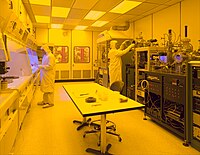
Photo from wikipedia
An ideal solar thermal absorber has a sharp transition between high and low absorptance at the wavelength where the blackbody emissive power begins to exceed the solar irradiance. However, most… Click to show full abstract
An ideal solar thermal absorber has a sharp transition between high and low absorptance at the wavelength where the blackbody emissive power begins to exceed the solar irradiance. However, most real selective absorbers have a fairly broad transition, leading to both solar absorption and thermal emission losses. Here, we model, fabricate, and characterize a highly selective semiconductor-dielectric-metal (Ga0.46In0.54As - MgF2 - Ag) solar absorber with an extremely sharp transition from high to low absorptance. The thin semiconductor serves as a selective filter, absorbing photons with wavelengths shorter than the bandgap and transmitting those with longer wavelengths. The highly reflective dielectric-metal rear mirror allows the structure to have very low emittance for longer wavelengths. These characteristics provide the absorber with a measured solar absorptance>91% below the bandgap wavelength and infrared emittance<5% at 100 C above the bandgap wavelength. This transition wavelength can be tuned by modifying the semiconductor composition, and modeling indicates that the absorber's optical properties should be stable at high temperatures, making the structure a good candidate for unconcentrated to highly concentrated solar thermal energy conversion.
Journal Title: Solar Energy Materials and Solar Cells
Year Published: 2022
Link to full text (if available)
Share on Social Media: Sign Up to like & get
recommendations!